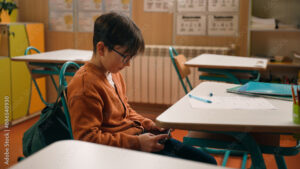In August 2024, Saskatchewan issued a cell phone ban in K-12 classrooms during the instructional period. Education Minister Jeremy Cockrill claims this policy will ensure students focus on learning and engage with teachers.
As an educator and tech-integrated learner, this change prompted me not only to reflect upon the pedagogy and policy, but also on implications of technology on digital citizenship and networked learning in education.
I understand how the purpose of this policy is to ban the illicit use of phones in class and focus in learning by reducing distractions and improve engagement. However, does it really fix the problem for everyone by following ‘one-size-fits-all’ approach? Are we missing out on the opportunity to teach digital literacy in spaces where we need the most, i.e. classroom?
When I looked into the reactions from teachers, students, administrators, and parents, it was enlightening to learn multiple perspectives on this subject. Some education experts expressed their disappointment on this new policy and believes that they are not focusing on an effective use of cell phones and when to use it in classroom. Kyle Robinson, an assistant professor of inclusive education at the University of Regina, argues this policy simply removes potential distractions and does little to equip students to navigate through real world.
While other educators wonder as to why the government is legislating this matter over far more pressing issues in schools for example, human resources, funding, class size, and complexity. Such issues were announced ‘loud and clear’ from teachers and parents but somehow such matters did not seem to have reached the ears of ministry of education. Marc Spooner, another professor from University of Regina, sees this cell phone ban as an act of political maneuver, showcasing support to teachers meanwhile ‘vilifying’ them during teachers negotiations earlier. He further adds that some schools and administrators already have such restricted usage of cell phones. Therefore, it is questionable as to whether such policy would bring out any meaningful changes.
On the other side of the coin, teachers are relieved with the new policy. Some students are distracted from cellphone texting and scrolling, and some use it to cheat during exams.
It’s no surprise that most of the students are displeased by this policy. In this era, its is rare to find anyone who does not own a cell phone. When you take away that from someone it gets difficult to function without facing some inconvenience. When we have to check time, do we look at the clock or phone? When we need to search for the meaning of a word, how many of us look at the dictionary? Hence, it is no surprise that students are not happy upon hearing the announcement of the cell-phone ban.
In my experience, as an educator in Bangladesh, I have faced more negative sides of using cell phone in classroom. The cell-phone usage ban was school board implemented restriction rather than government intervention. Despite the ban students often brought cell phone dummies to hide their primary ones. An incident lead to stricter cell phone restrictions when students secretly recorded videos without their teacher’s knowledge and later used the footage to create memes among themselves. In another incident, a student was caught cheating during exam using cellphone. Such incidents are not as frequent as it may sound but nonetheless taking place which disrupted the flow of the learning environment. I believe that implementing appropriate interventions to guide effective use of cellphones in student learning would be more fruitful than imposing outright ban. Because in my perspective, when students perceive a law imposed unfairly leads to growing resentment and resistance leading to rebellious behaviour.
As an educator I understand how challenging it is to manage children distracted on their cellphones in the classroom, but there are effective strategies to control and manage such situations. I came across this video on professional tips on how to manage a classroom with cellphones. Perhaps it will work and perhaps it may not, but there is no harm in discovering the effectiveness.


I really appreciate the thoughtful way you approached this topic. Your point about the policy targeting cellphones instead of addressing deeper classroom issues really stood out to me. Like you, I question whether a blanket ban actually solves anything when problems such as class size, funding, and overall classroom dynamics have a much bigger impact on student focus and engagement.
I especially value how you highlighted the missed opportunity to teach digital citizenship. Phones aren’t going away in the real world, and classrooms could be the best place to guide students in learning how to use them responsibly. Removing the tool entirely seems like a short-term fix that avoids the harder work of preparing students for a connected world.
I also found your inclusion of the students perspective really balanced. The student comment about smaller class sizes doing more for learning than a phone ban sums it up perfectly. Your personal experiences in Bangladesh added an important reminder that outright bans often create resentment and rebellion rather than genuine engagement. Maybe these youth need to start being activists though.
Thank you for sharing such a nuanced take on this policy. It’s encouraging to see a conversation that looks beyond the surface and calls for solutions that actually support learning.
Your final point about the need for “appropriate interventions” really connects with my own perspective. As a principal, I see the potential of cell phones every day. On my commute alone, I rely on my device to manage emergencies, connect with staff, and stay organized before I even walk into the building. Cell phones, when used responsibly, can be powerful tools of efficiency and connection.
I think the same principle applies to students. Research shows that restricting access to phones during school hours doesn’t actually reduce their overall use. Instead, it shifts the context in which they use them. If we don’t help young people develop digital citizenship and model appropriate use, they may be left to learn habits on their own, often in ways that are unhelpful or even harmful. Much like we teach safe driving rather than banning cars, it seems more productive to teach responsible cell phone use rather than prohibit it entirely.
Of course, misuse must be addressed, and strong boundaries are necessary. But there is also a tremendous opportunity: safety, quick communication with families, access to online resources, organizational tools, and even AI learning supports. If schools can frame cell phones as learning tools rather than contraband, we might foster more responsible behaviors and reduce the rebellion you mentioned.
In short, I see cell phones less as an enemy of education and more as a digital reality we must prepare our students to navigate.